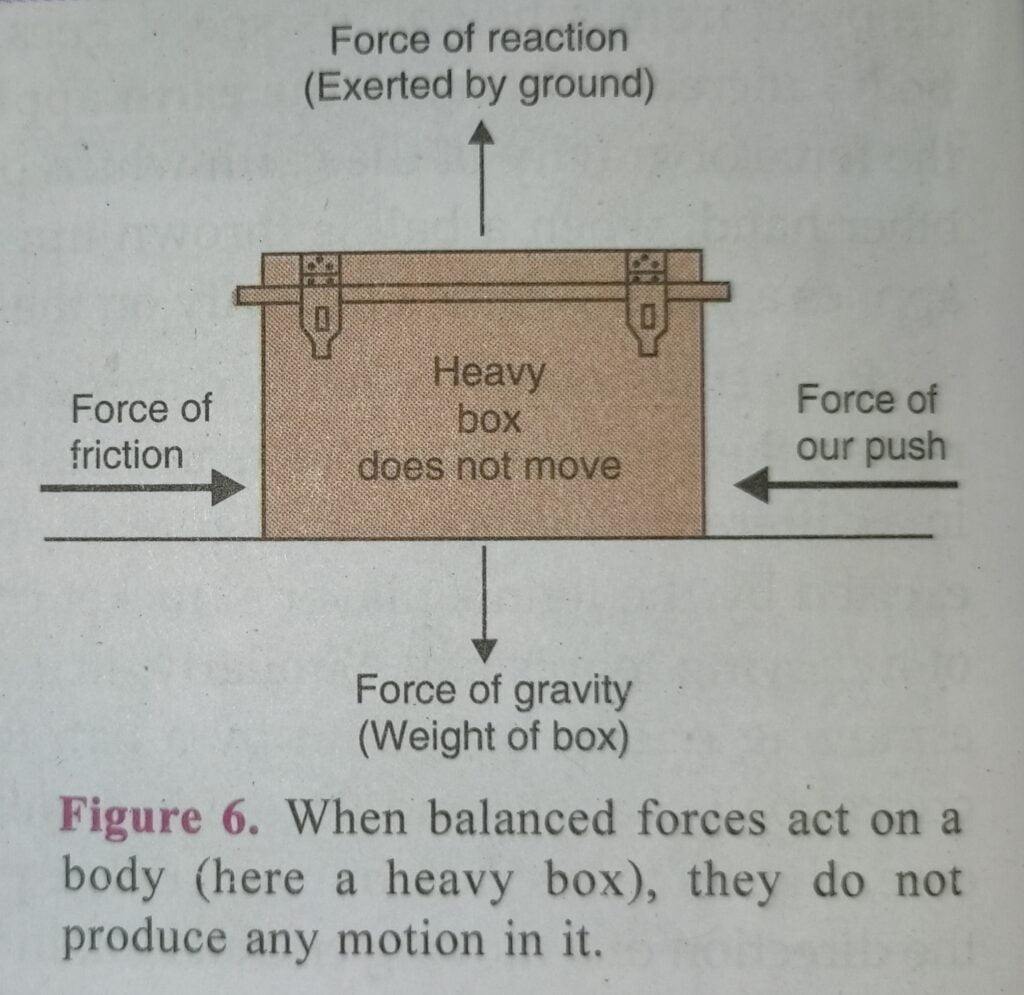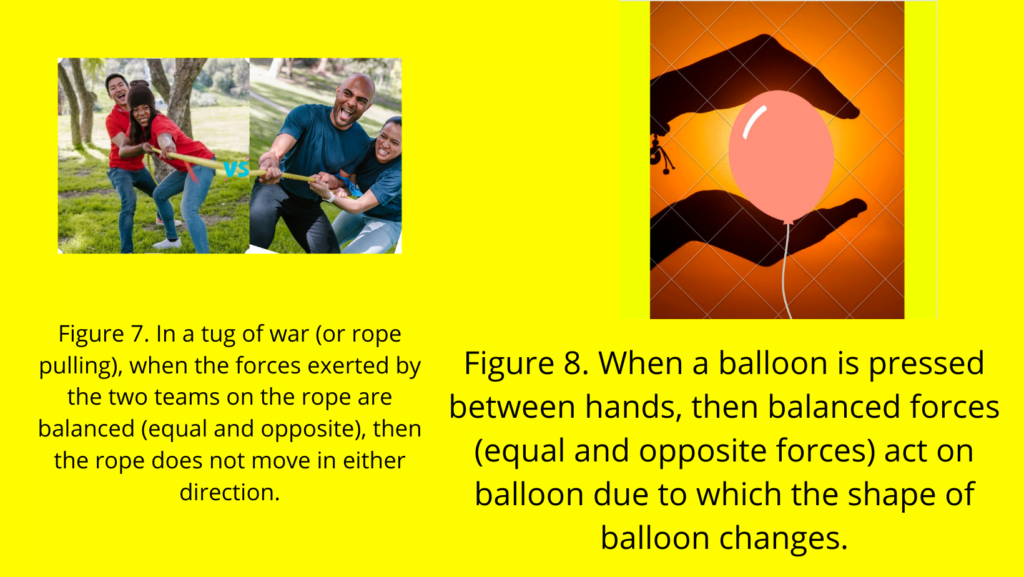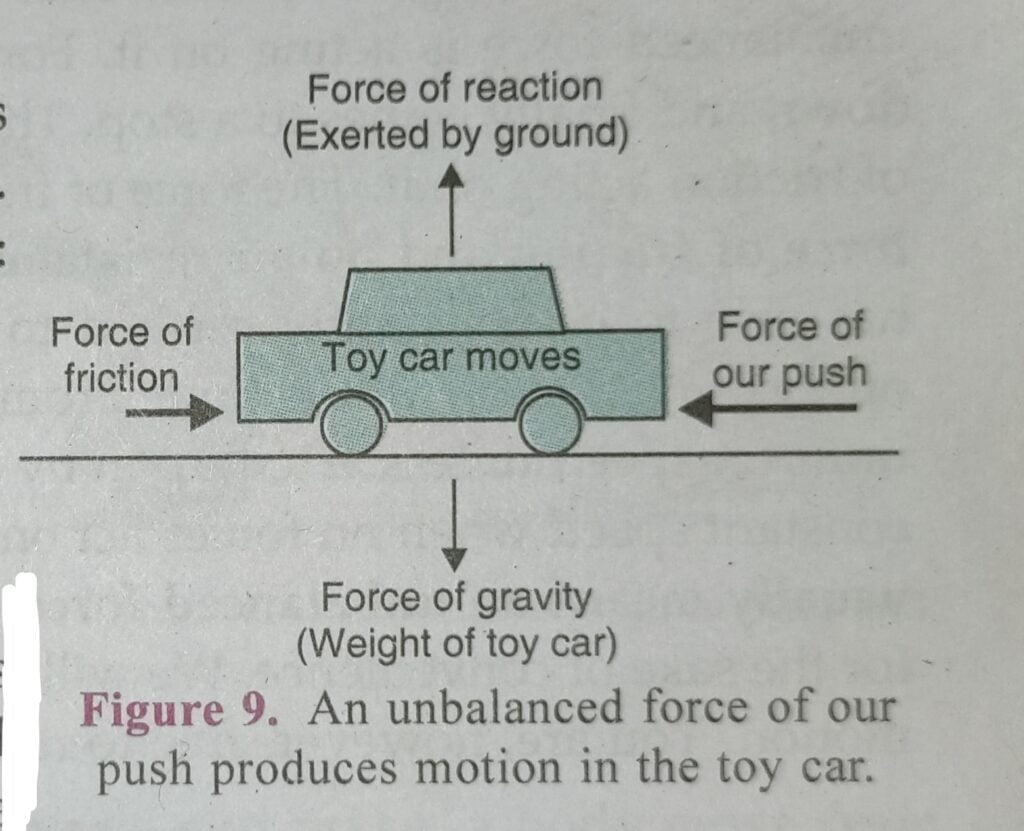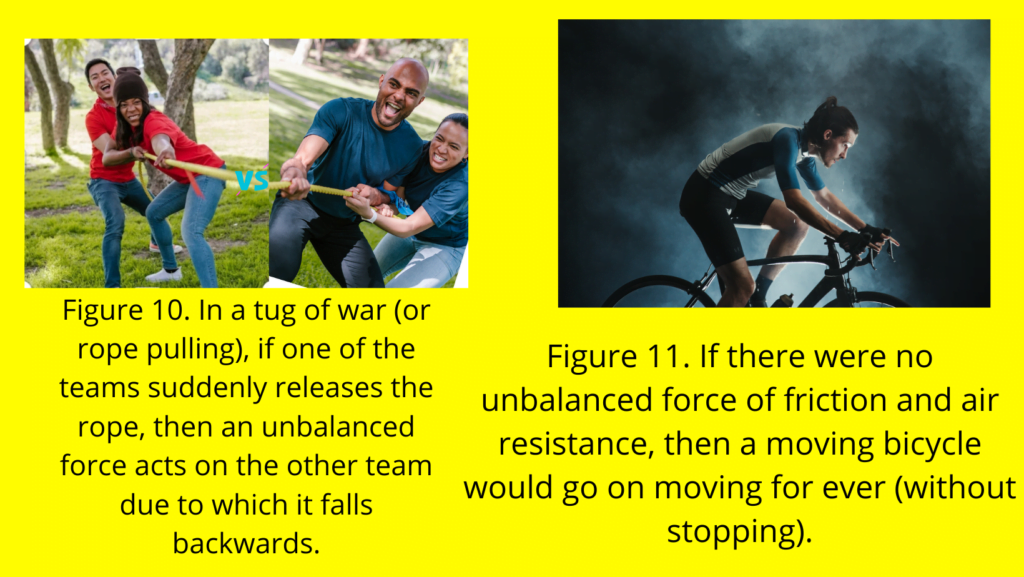Forces are of two types : Balanced forces and Unbalanced forces. We will now discuss balanced and unbalanced forces in detail, OnePlus by one. Let us start with balanced forces.
Balanced forces
If the resultant of all the forces acting on a body is zero, the forces are called balanced forces. A body under the action of balanced forces does not change its position of rest (or of uniform motion) and it appears as if no force is acting on it. This point will become more clear from the following example.
Suppose a heavy box is lying on the ground (Figure 6). Let us push this box with our hands. We find that the box does not move (and remains in its state of rest) though as many as four forces are acting on it. The four forces acting on the box are :

(i) Force of our push
(ii) Force of friction (which opposes the push and does not allow the box to move).
(iii) Force of gravity (which pulls the box downwards)
(iv) Force of reaction (exerted by the ground on the box upwards which balances the force of gravity)
Now , though the box is at rest , four forces are acting on it . Since the box does not move at all , we conclude that the resultant of all the forces acting on it is zero . The box , therefore , behaves as if no force is acting on it . The forces acting on this stationary box are an example of balanced forces . Please note that the force of our push on the box is balanced by the force of friction , and the force of gravity is balanced by the of war , force of reaction of the ground . Similarly , when we hold a suitcase steady at some height from the ground , the resultant force acting on the suitcase is zero and it does not change its position . Again , in a tug that is , in rope pulling between two teams , if the resultant of forces applied by the two teams is zero , the rope does not move in either direction . The forces exerted by the two teams are balanced . From this discussion we conclude that if a number of balanced forces act on a stationary body , the body continues to remain in its stationary position . Similarly , if a number of balanced forces act on a body in uniform motion , the body continues to be in its state of uniform motion .

Though balanced forces cannot produce motion in a stationary body or stop a moving body, they can, however, change the shape of the body. An example of the balanced forces changing the shape of a body is in the squeezing of a rubber ball or balloon. When we press a rubber ball or a balloon between our two hands, the shape of rubber ball or balloon changes from spherical to oblong. In this case we apply two equal and opposite forces (balanced forces) with our hands. Though the ball or balloon does not move, its shape changes. We will now discuss the case of unbalanced forces.
Unbalanced Forces
If the resultant of all the forces acting on a body is not zero, the forces are called unbalanced forces. When unbalanced forces act on a body, they produce a change in its state of rest or of uniform motion. That is, unbalanced forces can move a stationary body or they can stop a moving body. In other words, unbalanced forces acting on a body can change its speed or direction of motion. This point will become more clear from the following example.
Suppose a toy car is lying on the ground (see Figure 9). Let us push this car with our hand. We find that the toy car starts moving. Now, in this case also four forces are acting on the toy car. These are:

(i) Force of our push
(ii) Force of friction
(iii) Force of gravity (
iv) Force of reaction of ground
In this case also, the force of gravity on the car acting downwards and the force of reaction of ground acting upwards are equal and opposite, so they balance each other. Now, due to the wheels of the toy car, the opposing ‘force of friction’ is much less here. The force of our push is, therefore, greater than the force of friction in this case, so they cannot balance each other. Thus, the resultant of all the forces acting on the toy car is not zero. There is a net unbalanced force acting on the toy car which makes the car move from its position of rest. The toy car moves in the direction of greater force (which is the direction of our push). Thus, to move a stationary object, we have to push it with a force greater than the opposing force of friction.
Please note that even the heavy box shown in Figure 6 can be moved if pushed with a very strong force (by more than one person). This is because in that case the force of push will become greater than the opposing force of friction. An unbalanced force will then act on the heavy box and make it move. When we are holding a suitcase above the ground, then the force of gravity acting on the suitcase is balanced by the upward force of our hands. Now, if we release the suitcase from our hand, then the unbalanced force of gravity acts on it and the suitcase falls to the ground. In this case the force of gravity

produces motion in the suitcase. Again, in a tug of war, if one of the teams suddenly releases the rope an unbalanced force acts on the other team due to which it falls backwards. So, in this case, an unbalanced force results in the motion of the weaker team alongwith the rope they are holding. From the above examples it is clear that when an unbalanced force acts on a body, it produces motion in the body. Another point to be noted is that an unbalanced force can also stop a moving body. For example, when a ball is rolling on the ground, an unbalanced force of friction acts on it which brings the ball to a stop after some time.
We have just said that an unbalanced force acting on a body changes its speed or direction of motion. The reverse of this is also true. That is, if the speed or direction of motion of a body changes, then some unbalanced force is acting on it. For example, when we stop pedalling a moving bicycle, then it slows down and finally comes to a stop. The slowing down of the moving bicycle is due to the unbalanced force of friction acting on it. The force of friction opposes the motion of the bicycle. If there were no unbalanced force of friction and no air resistance, a moving bicycle would go on moving for ever. Similarly, a cart has also to be constantly pushed to keep it in motion. This is because an unbalanced force of friction opposes its motion all the time. From this discussion we conclude that a body will continue to move with uniform speed unless acted upon by an unbalanced force. It was Galileo who said that objects move with constant speed when no forces act on them. Please note that when we talk of a force acting on a body, it usually means an unbalanced force. We will not use the word ‘unbalanced’ with ‘force’ again and again for the sake of convenience. We will use only the term ‘force’ in writing the definitions of Newton’s laws of motion. You are, however, free to use the term ‘unbalanced force’ if you so desire.

